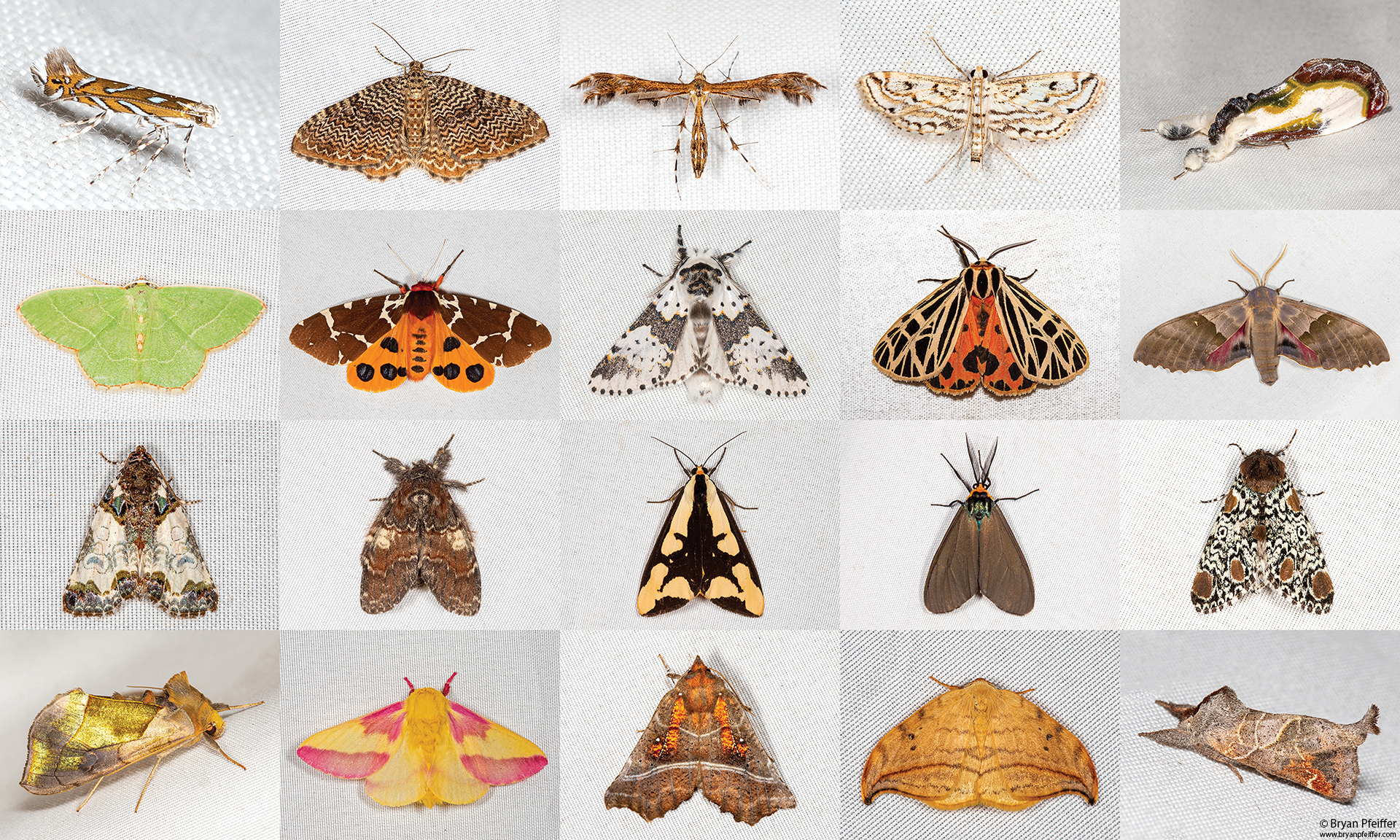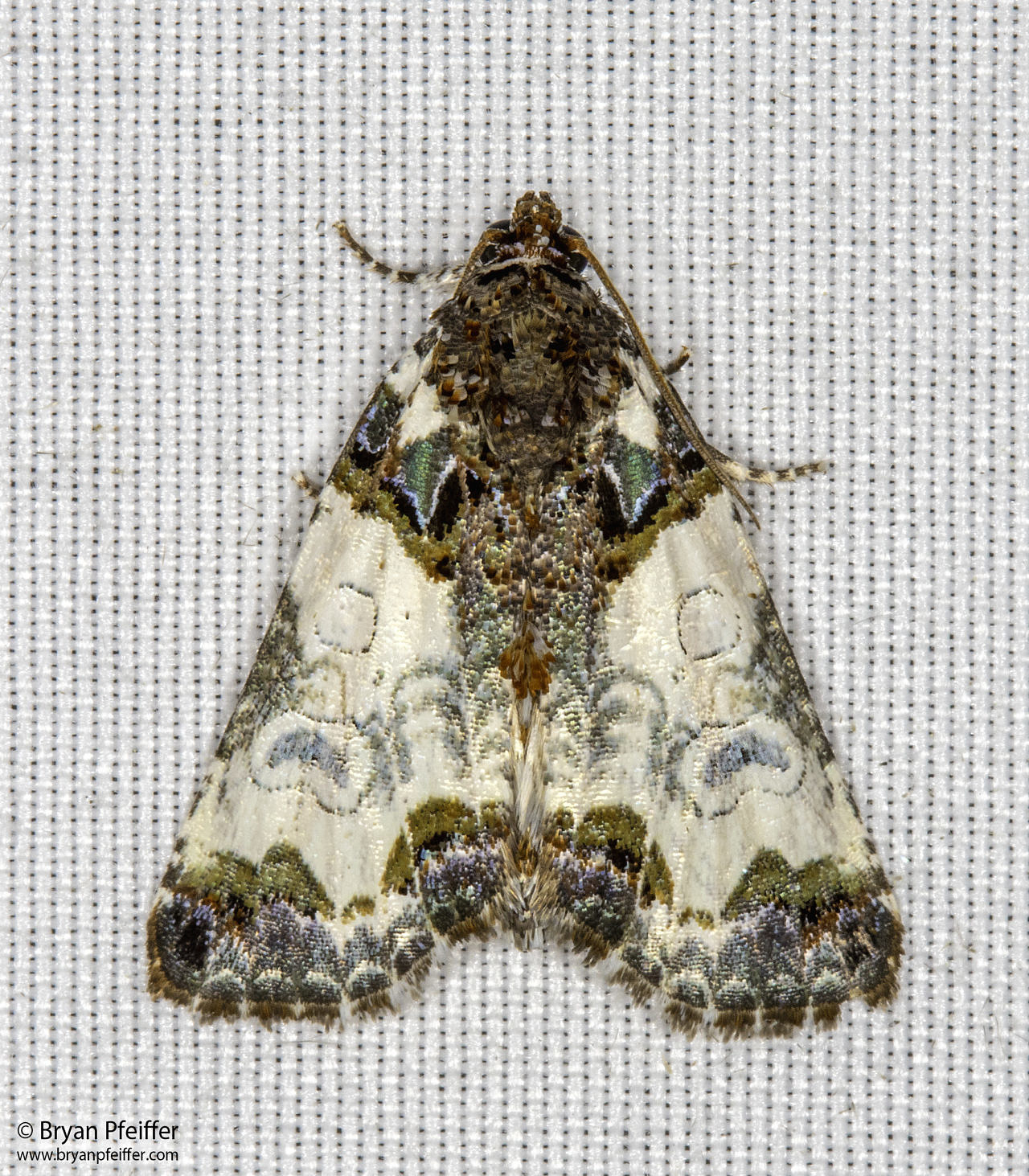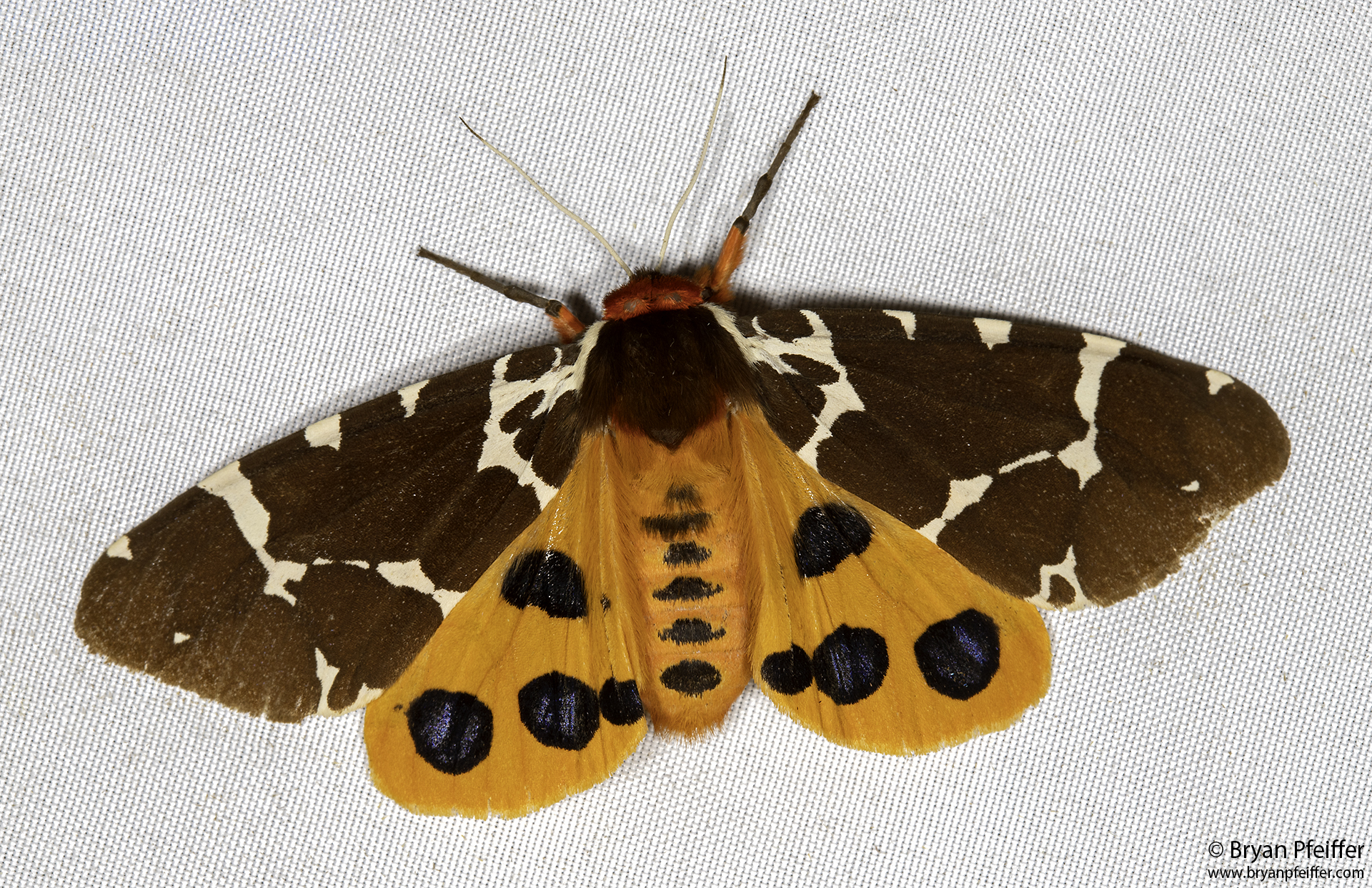Be the Flame and the Moth
My Latest Essay for The Boston Globe
Image: A sampling of moths from my backyard during National Moth Week.
Each night they fly to our front porches and backyards by the thousands. Some no bigger than a grain of rice, others the size of your palm, they twinkle gold and silver and glow hot pink, metallic blue, or 50 shades of brown. Our names for them attest to their diversity (and to the whimsy of biologists): Chocolate Prominent, Beautiful Wood-nymph, Once-married Underwing, Tufted Bird-dropping, Blinded Sphinx, and Skunk Twirler.
These are among the moths now flying here in New England.
Let us dispense with moths’ general reputation as pests or drab creatures of the night. Ornate as any other insects, including butterflies, plenty of them fly by day. Yet what I find most compelling is that moths, more so than any wildlife, bring to our doorsteps inklings of the profound diversity of life on earth.
Even among those of us who study it, biodiversity is somewhat of an abstraction. We’re still not sure how many living things inhabit the planet. A widely cited study puts the total at 8.7 million species, with somewhere around 1.2 million to 2 million of them described and named and known to science. So much remains vita incognita.
How can any of us even sense such diversity? Birds get lots of attention. Even so, a dedicated birder in Massachusetts, for example, would need to be out and about much of the year to encounter even half of the state’s 500 or so recorded species. Plants aren’t as elusive. Yet a botanist might need a few years and many miles to see and identify more than 500 of the 3,500 or so vascular plant species in all of New England.
Moths put those numbers to shame. It isn’t only that they are more varied and abundant: My home state of Vermont, for example, has about 115 butterfly species — and yet more than 2,200 moth species. In the capital city of Montpelier, where I live, we have photographed more than 700 moth species at lights and on plants within city limits. Greater Boston hosts more than 1,000 moth species. Because moths, as caterpillars, eat plants, more plants means more moths, which is why small, leafy towns tend to have higher moth diversity than cities.
To be sure, other insects are more diverse than moths, and none more so than beetles. The English polymath J.B.S. Haldane, asked to speculate on the composition of the universe, is reported to have said that if the cosmos is divine in origin, the Creator “has an inordinate fondness for stars and beetles.”
Yet beetles do not visit us in multitudes, not like moths with their inordinate fondness for light. And during this National Moth Week, which ends at midnight tonight, scientists and other curious people around the world have been beckoning moths by day and night — to enjoy and study them and to learn more about how we’re losing them, among other insects, in the extinction crisis. (Ultra violet or mercury-vapor lights are best for studying moths, but porch lights also work, all of which we later turn off so that the moths can go about their usual nighttime business.)
During two nights of blissful sleep deprivation in my small backyard last weekend, I photographed more than 120 moth species. Clymene Moth is marked like a flying Rorschach test; Harris’s Three-spot is inexplicably and undeniably pleasing; Hologram Moth does indeed cast an ethereal glow; and Orange-headed Epicallima is a fireworks show packed into a centimeter.
Even in our most unnatural of places, moths remind me of a world great and diverse — and yet so undeserving of the mess we have made of it. Among moths we can find four wings and a million prayers.
All we need is to leave a light on for them.
Postscript: By the way Giacomo Casanova is reported to have said, “Be the flame, not the moth.” I say be both.
Moth Montage Species (left to right):
Top Row: A leaf miner (Parectopa or Acrocercops species), a Geina plume moth, Watermilfoil Leafcutter (Parapoynx allionealis), a Rheumaptera species, Beautiful Wood-Nymph (Eudryas grata).
Second Row: Red-Fringed Emerald (Nemoria bistriaria), Garden Tiger Moth (Arctia caja), Furcula species, Virgin Tiger Moth (Apantesis virgo), Modest Sphinx (Pachysphinx modesta).
Third Row: Tufted Bird-Dropping Moth (Cerma cerintha), Chocolate Prominant (Peridea ferruginea), Clymene Moth (Haploa clymene), Virginia Ctentucha (Ctenucha virginica), Harris’s Three-Spot (Harrisimemna trisignata).
Bottom Row: Hologram Moth (Diachrysia balluca), Rosy Maple Moth (Dryocampa rubicunda), The Herald (Scoliopteryx libatrix), Arched Hooktip (Drepana arcuata), Apical Prominent (Clostera apicalis).




My wife found a moth on the side of our house this morning. It had black along the triangle shape with what appears to be an inverted cross on its back.
I hope you’re finding those beauties, Allison!
Thanks so much, Georgeann. Still more moths to come this month.
Yep, there is some general concern about declines in Cecropia and other giant silkmoths. We’re watching it:
https://val.vtecostudies.org/newsfeed/still-time-to-contribute-to-the-vermont-giant-silk-moth-cocoon-watch/
Bryan, another great column. thanks. We had a sphinx moth banging around the screens last night. lovely. and a couple years ago; a cecropia! but no more. Is there a decline?
Amazing moths here–new species for me every time I light up. I am in need of sleep!
Awesome!! I just emailed you my favorite finding! I’ve never seen one of these beauties before! Now I’m looking EVERYWHERE!!! Thanks for a great article!
Thanks, Nancy!
… and you as well on the illumination front, Bernie!
Can’t go wrong with Rosy Maple Moth! Two broods at our latitude!
Thanks, Ann. I hope all is well with you out there in the wilds.
You’re most welcome, Katherine. “Stunners” indeed!
So very kind of you, Bill. It’s always great to hear form you. Send my best to the crowd at your place!
You are more than welcome, John. Thanks for reading (and, of course, for all you do and see).
I’m not sure about a range expansion, but Clymene seems to be having a good year! Lots here in Vermont as well.
Keep us posted on your northern moths, David. Great to hear from you!
Seems to be a good year for Clymene, Karen. I’m really enjoying them as well.
You’ve got some charismatic moths there, Lucy. Enjoy!
Thanks so much, Kerri!
Lots more diverse than birds, Jo! 🙂
Thanks, Juan. Always great to hear from you.
… and your observations and photos are indeed welcome and wonderful on the blog (https://forestandfield.blogspot.com/). (That Scarlet-winged Lichen Moth is one I have yet to see.) Thanks, Woody!
Well, in general, the more varied your herbaceous diversity, Jude, the higher your moth diversity. Shading and lack of flowering plants means lower butterfly diversity. But you should have fairly good moth diversity. For moth study, UV lights really do bring them in. (Then turn them off after observation.)
Your collection is a bug lover’s dream!! How I wish I could’ve found so many colourful moths! It’s not from lacking of trying either. At our last home, I purposely kept the backyard rather unkempt since I enjoyed watching the frequent visitors – skunks, possums, lots of raccoons, infrequent coyotes and once, even a pair of deer. While there were some more colourful moths, there wasn’t many. Still, I took what I could find and shot them as I enjoyed being outside in the evening. I wonder if the scarcity of different moths (butterflies too) was due to it being quite shaded and surrounded by tall Douglas firs and cedars.
Nice post and beautiful photographs. I’ve posted about National Moth Week for several years with photos of moths from our yard. Yes, moths are fascinating and beautiful creatures.
Nice article-Thank-you Bryan, I was a bit late getting to it but it was well worth the wait. Cheers.
Thank you for this article. No idea there were so many of them. And you tell us so well!
Great article!
In the last two weeks, I have seen, photographed, and (with help!) figured out we have snowberry clearwing and blinded Sphinx moths in our Minnesota yard! I opened your email and laughed at the great timing of your essay topic and my yard adventures – thank you!!
Every day I seem to find a new creature in my own backyard, and am fascinated by the many moths. Some aren’t fancy, but interesting. A moment with a Clymene moth was a recent highlight. Some of them aren’t fancy but just as interesting. Enjoyed your interesting writing on this subject.
Thanks Bryan – your writing continues to be enjoyable! Going to get my UV light fired up this evening.
Hi Bryan – found my first ever Haploa clymene in Nova Scotia ! Perhaps expanding their range? Unmistakable FW pattern .. Enjoy ur blogs
Thank you!
Bryan
Your observations, inspections and Introspections about the world we live in but too often only notice with your skilled assistance are a treasure. Thank you!
Thanks for this ode to the too-often overlooked moth! Those images are stunners, too.
I’m visiting family in Virginia for the last two days of moth week, and your article was a delight and an eastern revelation. Thank you! Last night added about 60 new species to my growing collection of photo wonders.
I’ve been mad for moths ever since I discovered a rosy maple moth clinging to our door jamb in Lubec, Maine. l plan to spend a night awake and stationed on the other side of the door soon! Thank you for the beautiful reminder.
You’ll love it, George — and you’ll be busy and sleepless!
Thanks so much, Nancy.
Yay indeed!
That’s Clymene Moth (Haploa clymene). Seems to be a good year for them.
Yay moths!
Another inspiring read Bryan! With my new camera, I’ve just begun exploring this diverse domain. I suspect a UV light May be in my future.
Wonderful article!
What species is the moth in the middle column, third photo down, the dark brown and cream one that looks like an ink blot test? I just found one on a squash plant in my garden today at Paradox, NY.
Thanks.
Bryan,
You are the flame, we are the moths! You have drawn us to you, you illuminate us.
VT Bug Eyed Bernie